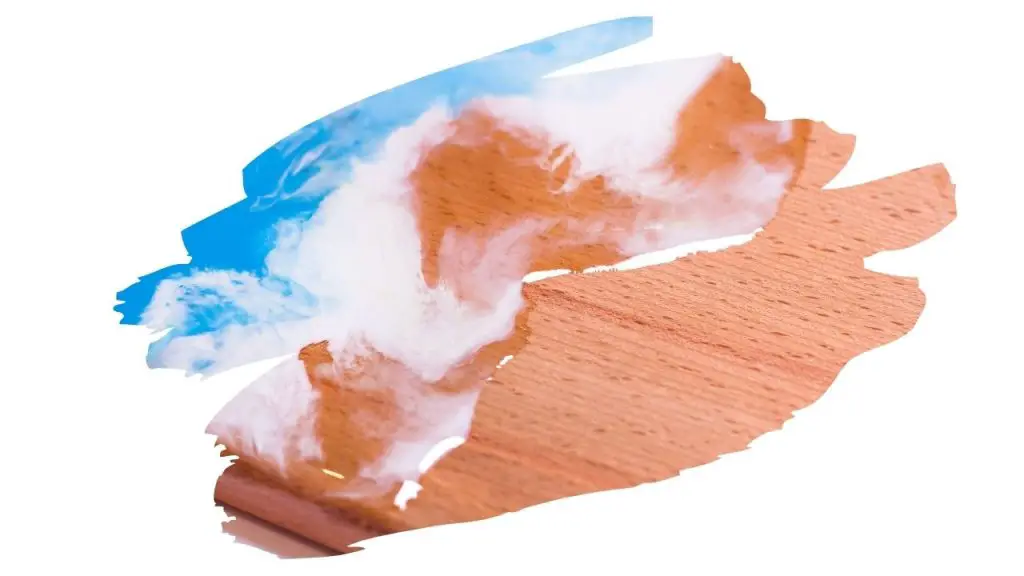If you’ve ever worked with epoxy before, you’ve probably learned through trial and error that this resinous stuff doesn’t do it’s best work when applied directly onto bare wood. This is because epoxy likes to seep into gaps and cracks.
As a general rule of thumb, epoxy doesn’t really penetrate wood the way that say a wood stain or oil can. But, when it does, it can become a problem if that epoxy manages to work its way into wood joints.
So, to prevent this, you might want to add an undercoat of something that’ll fill those gaps before that epoxy does.
And this is where shellac comes in. This honey-colored finish not only enhances the beauty of natural wood, it also protects it too.
But can it happily take on a top coat of finish? Or, to be more precise, can you put epoxy over a shellac finish?
You can apply epoxy over a coat of dewaxed shellac. A water-based epoxy resin product will stick and stay on this type of shellac product. This is because dewaxed shellac isn’t oil-based or water-based. It is in fact an alcohol-based solution.
Now, this is all well and good, but can shellac really prevent epoxy from bleeding through into those joint gaps underneath? And do you even need an epoxy sealer over a shellac finish in the first place?
Well, lets dive into the 3 key things you need to know before you apply that Shellac/Epoxy combination coat to your project…

This post may contain affiliate links to products that we receive a commission for (at no additional cost to you). Learn more here.
No. 1) What Do You Use Over Shellac?
You can use any finish or sealer over shellac, provided you stick to two rules;
- 1. You use a dewaxed shellac product.
- 2. The finishing top coat you are using isn’t oil-based.
Oil-based finishes work best by soaking into wood grain. And, if there is a layer of shellac between the oil finish and bare wood, then that oil finish won’t perform at its best.
So, top coats of polyurethane, epoxy, and even gel stain will stick to dewaxed shellac.
Related Post: Can You Put Polyurethane Over Gel Stain? (Best Practice Revealed!)
What Is The Difference Between Dewaxed and Waxed Shellac?
The main difference is clear in the name; Dewaxed Shellac is just Waxed Shellac that has had all wax removed.
You see, oil-based and water-based products struggle to stick to waxed shellac. This is because the natural wax found in shellac makes it hard for oily/water products to hang onto.
So, if you want to add any sort of sealer on top of shellac, you will need to make sure you are using a dewaxed product.
Something like Zinsser Bulls Eye Dewaxed Shellac is perfect for this. And you can check out the latest prices for this shellac product over on Rustoleum by clicking here.
Related Post: 7 Surprising Advantages (And 6 Disadvantages) Of Wax Finishes On Wood
No. 2) What Is The Difference Between Epoxy And Shellac?
There are 2 key things that separate epoxy and shellac;
Durability
The most stark difference between the two is their level of toughness. Epoxy is much more durable than a shellac finish, and doesn’t require anywhere near as much refinishing top up work either.
Waterproofing
Shellac finishes can do a fairly decent job at water-resistance. This non-toxic finish can handle a bit of water vapour here and there. But it is not waterproof.
A shellac finish can be easily damaged by water. So you shouldn’t use shellac alone to protect wood that will be exposed to moisture or damp.
Epoxy, on the other hand, is incredibly waterproof. Used not only in clear finishes, but in primers and paint too, this stuff can last over a decade when applied even to outdoor structures.
Related Post: Can I Apply Water Based Polyurethane Over Danish Oil? (Solved!)
No. 3) If You Had To Choose Would You Go With Epoxy Or Shellac?
If you absolutely had to decide on one over the other, then epoxy is the obvious choice. Shellac simply doesn’t offer enough waterproofing to protect wood over time.
Side Note: Having said that, if water exposure isn’t going to be a problem for your project, then shellac is the better option. Why? Because it makes wood look fantastic.
Related Post: Can You Put Polyurethane Over Gel Stain? (Best Practice Revealed!)
So To Sum Up…
Waterproofing your craft is an important final step to completing any project. Which is why adding something extra over a shellac finish isn’t a bad idea.
But, not all shellac products play well with others. Especially when natural shellac likes to shrug off most top coat sealers.
However, if you stick to using a dewaxed shellac product, you should be able to get epoxy to coat nice and evenly over it.
Good Luck!
Before You Go: Did you know that epoxy is just one of a few different sealers that go well over shellac. Check out our post ‘Can You Put A Durable Lacquer Finish Over Shellac?‘ to learn more.
References
Shellac/nanoparticles dispersions as protective materials for wood | SpringerLink

